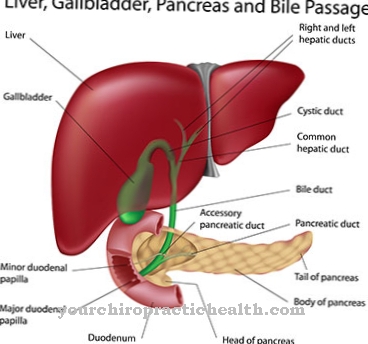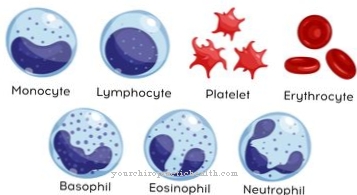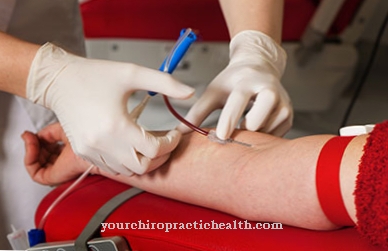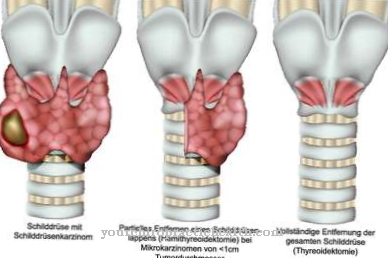The Infantile Cerebral Palsy (ICP) is brain damage that can occur both before birth and during and after the birth process. The symptoms are manifold, a cure is not possible. However, the symptoms can be alleviated through the early use of various therapies.
What is Infantile Cerebral Palsy?

© suppakij1017 - stock.adobe.com
The infantile cerebral palsy is a posture and movement disorder caused by early childhood brain damage. The damage can be caused before birth, but also during the birth process and in the first year after birth.
Infantil means “concerning the child, childlike”, cerebral comes from the Latin term cerebrum for “brain” and parese is the medical term for “paralysis”. The disorders of infantile cerebral palsy are very diverse, depending on which region in the brain is damaged. Excessive muscle tension and poor coordination of movements are typical.
Seizures often occur, sometimes there is a reduced intelligence and abnormal behavior. Infantile cerebral palsy is rare, only around 0.5% of newborns are affected. The disease occurs more often in boys than in girls; Premature babies have an increased risk of infantile cerebral palsy.
causes
The infantile cerebral palsy can be triggered by various causes, but we do not always know the exact processes that led to the brain damage. The prenatal (prenatal) causes of infantile cerebral palsy include poisoning from increased consumption of alcohol or medication by the mother, infectious diseases such as toxoplasmosis or rubella, blood group incompatibility between mother and child, insufficient supply of the placenta or metabolic disorders.
Perinatally (during birth), infantile cerebral palsy can be caused by a lack of oxygen, for example when the umbilical cord is pinched off. But also cerebral hemorrhages, which can occur in difficult births, can lead to infantile cerebral palsy.
The detachment of the placenta is also a possible cause of infantile cerebral palsy. After birth (postnatal), infections or brain trauma (damage to the brain) can cause the disease.
Symptoms, ailments & signs
In infantile cerebral palsy (ICP), various movement and posture peculiarities occur. Weak muscles and slowed motor skills are characteristic of the disease. Depending on the location of the brain damage, further symptoms and complaints may arise.
Mostly there are involuntary movements, coordination disorders and seizures. Furthermore, the affected children suffer from reduced intelligence, which results in learning disabilities and psychological complaints. The sick often show behavioral problems, for example aggression or strong fears.
As a result of the individual movement disorders, permanent damage to muscles, bones and joints can occur. In severe cases, bones and joints become deformed, which usually leads to further health problems. An equinus foot, i.e. a foot with toes pointing upwards, is typical for ICP. The severely shortened Achilles tendon can also lead to chronic pain and an unusual gait.
A curvature of the spine is also characteristic of infantile cerebral palsy. Hip malpositions and limb shortening can also occur. Finally, the disease causes spastic syndromes. The muscles are permanently tense, resulting in cramps and pain.
In addition to muscle paralysis, the joints may stiffen. Symptoms of paralysis occur primarily on the legs and feet. The ICP symptoms can vary widely; most patients experience a mixed form of the symptoms mentioned.
Diagnosis & course
The most common symptoms of infantile cerebral palsy are posture and movement disorders. But there are far more and very different symptoms with the disease, depending on which brain areas are affected by the damage.
Doctors speak of various syndromes of infantile cerebral palsy, that is, of several symptoms that occur together. The most common is the spastic syndrome, in which muscle tension is increased, cramps develop and paralysis can occur.
In the hypotonic syndrome of infantile cerebral palsy, it is mainly the cerebellum that is damaged. This leads to very little muscle tension with overstretched joints; the children often have intellectual disabilities and sometimes epileptic seizures occur. In the congenital (congenital) ataxia syndrome of infantile cerebral palsy, children have difficulty controlling and coordinating their movements. They have imbalances, paralysis and their movement development is slowed down.
The dyskinetic syndrome, finally, is characterized by alternating muscle tension, spastic paralysis and so-called athetoses (uncontrolled violent movements of the limbs). Since movement and posture disorders can also be triggered by other causes, the doctor must examine the affected child carefully and draw up a detailed anamnesis. Only through the results of all examinations and careful observation of the child can he make the diagnosis of infantile cerebral palsy with certainty.
Complications
This disease causes severe brain damage. As a rule, it is not possible to treat these symptoms causally, so that only symptomatic therapy is available for those affected. The patients suffer from severe disturbances in movement and concentration. Equilibrium disorders can also occur, which significantly limit the everyday life of the person concerned.
The patient's muscle movement is also restricted and convulsions or epileptic seizures occur. These can also lead to death. In some cases, the patients also suffer from paralysis or spasticity. Children in particular can become victims of bullying or teasing as a result. The general development of the child is clearly disturbed and restricted by the disease.
The person concerned may need the help of other people in adulthood. Visual disturbances can also occur. The patient's intelligence is also reduced in most cases. Treatment is primarily aimed at reducing symptoms. In many cases, however, the parents or relatives also need psychological treatment.
When should you go to the doctor?
Infantile cerebral palsy is usually diagnosed immediately after birth and treated in hospital. Affected children suffer from a variety of complaints and must be closely monitored and treated by a doctor. For this reason, the child has to be taken to a specialist several times a week, who can clarify the current state of health and adjust the medication if necessary. If serious complications arise, the emergency services must be called.
In the case of recurring muscle cramps, spastic attacks or symptoms of paralysis, immediate medical help is necessary due to the risk of accidents and falls. In addition to the family doctor, various doctors must be called in. The posture damage requires physiotherapy and occupational therapy, while speech disorders must be treated by a speech therapist. Neurologists and internists are responsible for complaints such as epilepsy, developmental disorders and pathological reflexes. The parents of affected children should first speak to the family doctor or pediatrician and together with them decide whether and which specialists should be included in the therapy.
Treatment & Therapy
The infantile cerebral palsy requires extensive treatment with therapies from different areas. The success is largely dependent on an early start of the treatments. Infantile cerebral palsy cannot be cured, but the affected child can be given the best possible support in his development and his abilities.
As a rule, a therapy plan is drawn up, which is then followed. The children are supported by speech therapy, physiotherapy and occupational therapy. This improves their mobility, their ability to speak and coping with their everyday lives. In addition, neuroleptics (calming nerves) and antispastics (against cramping of the muscles) can support the therapy.
Functional splints, walking aids and other aids can be used to achieve better mobility. In the case of severely shortened tendons, excessive joint misalignments or if the spine is very crooked, surgical interventions are also carried out in infantile cerebral palsy. Tendons are lengthened; Severing nerves to relax tight muscles; Bones rearranged to bring joints back into the anatomically correct position or unstable (loose) joints stiffened.
Outlook & forecast
The disease has an unfavorable prognosis. Despite all efforts and various therapeutic approaches, there is irreparable damage to the brain. These do not allow a recovery or complete freedom from symptoms with the current medical possibilities. The assessment of the prospect of symptom relief is made individually immediately after birth or in the further development of the child. Only then can the extent of the cerebral injuries be foreseen.
The aim of treatment is to reduce existing impairments and improve the general quality of life. The movement possibilities are trained and the cognitive performance should be optimized in individual exercises. The social integration of the person concerned into the environment is monitored, as behavioral problems often occur that trigger interpersonal disorders.
Despite an extensive and multi-layered therapy plan, the patient is in many cases dependent on the daily help and support of relatives or a care team. An inpatient stay is necessary in particularly difficult situations. The language skills and intelligence do not correspond to the competencies of a healthy person. This makes it difficult to shape an independent lifestyle. Various tests are used to assess the options available. Thereafter, forms of treatment will be initiated as soon as possible. The sooner therapy can begin, the better the prospects for an improved quality of life and alleviation of symptoms.
prevention
One can against infantile cerebral palsy not preventive, but with regular examinations during pregnancy, pathological processes can be detected early and possibly treated. If a child has infantile cerebral palsy, no cure is possible, but the symptoms and disabilities can be alleviated by starting treatment early.
Aftercare
Infantile cerebral palsy is a disability that occurs primarily in children. In Germany, 195,000 children are affected, which means, conversely, that one in 500 children develops cerebral palsy. The term is made up of the words "cerebrum" (Latin for "brain") and "paresis" (Latin for "paralysis").
However, it is not a question of a paralysis of the brain, but of damage to it, which results in physical paralysis. The exact cause cannot be determined in around half of the cases, but it can be established that oxygen deficiency is the most common cause of infantile cerebral palsy.
Disabilities or damage can arise in three different stages: before birth (prenatal), during birth (perinatal) and after birth (postnatal). The disability can have an impact in several ways. If the body is paralyzed on one side, one speaks of hemiplegia including spastic hemiparesis.
If only the lower limbs are affected, we speak of paraplegia including spastic paraparesis. If all four limbs are paralyzed, a tetraplegia including spastic tetraparesis is diagnosed. Often there is an increased muscle tone in connection with involuntary incorrect movements, so-called athetoses.
Once an organism shows infantile cerebral palsy, it can no longer be eliminated. For this reason, risk groups should receive appropriate preventive treatment during pregnancy. For example, if an expectant mother consumes a lot of alcohol or various substances, it is important for professionals to ensure appropriate medical care and to act preventively, for example by providing information.
However, if infantile cerebral palsy does occur, the balance between social assistance (ID card for the severely disabled, remedies (medication), aids (devices), care needs, financial support) and psycho-social assistance (acceptance of the disease or disability, effects on the social situation, Effects on the family system, empowerment).
You can do that yourself
The top priority is to maintain mobility. This avoids pain and contractures (restricted movement of joints). If affected limbs can be moved arbitrarily, this mobility should also be encouraged.
It is therefore important to carry out everyday activities such as dressing, washing and eating as independently as possible. Often this is only possible with aids or small changes. An example: a person affected can pull up his trousers, but cannot close the trouser button. Trousers with an elastic waistband, on the other hand, are easy to put on. Or: A fork with a thickened handle can be held much more securely and brought to the mouth than a normal fork with limited manual dexterity.
Another important point to maintain mobility is self-stretching. Hypertonic muscles, i.e. Muscles with increased tension are stretched to prevent shortening and joint restrictions. For example, the healthy hand can extend and bend the fingers of the affected hand. The movements during self-mobilization should be very slow and even, so the muscle tension can decrease. A bath at a pleasant temperature or rocking in a hammock can also help relax the muscles.













.jpg)

.jpg)
.jpg)











.jpg)